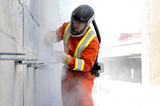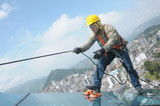Blog
New Wildfire Emergency Regulations Issued by the CAL/OSHA
Wildfires continue to wreak havoc throughout California and beyond. In response to the latest round of wildfires, California and the Occupational Safety and Health Administration (OSHA) have enacted an emergency regulation that’s meant to protect outdoor workers from potentially dangerous wildfire smoke. It’s not just firefighters who have to worry about breathing in various toxins and smoke. Gardeners, landscapers, construction workers, and anyone else who has to be outside as part of their job
…
Nov 12th 2019
Silica Dust Mask: What Type of Respirator Should I Use for Silica?
We make specific recommendations below, but first a little background...
Working in the manufacturing or construction industries usually means working near what’s known as silica dust, or respirable crystalline silica, which is commonly found in and around construction and manufacturing sites. It’s created by cutting, grinding, drilling, or crushing stone, rock, concrete, brick, mortar and other construction materials.
Silica dust poses a direct and serious threat to the health of
…
Oct 17th 2019
Don't Be a Hot Head: Accessories to Keep You Cool Above The Shoulders
As a business owner, it’s your responsibility to keep your employees cool on the job. Excessive heat either indoors or out can lead to a range of physical and mental symptoms. If your staff needs to work long hours in the blazing sun or a steamy warehouse, you need to provide the proper equipment to make sure they stay cool and comfortable on the job. Learn more about common heat-related illnesses and what you can do to keep your employees out of harm’s way.
The Dangers of Heat Exhaustion
…
Apr 18th 2019
Need To Know About New OSHA Silica Dust Rules and Regulations?
The U.S. Department of Labor first emphasized the life-threatening hazards of respirable crystalline silica in the 1930s. Today, according to OSHA, approximately 2.3 million Americans are exposed to silica on a regular basis in the workplace.
Heavy equipment operators, construction, and plaster/drywall workers are the most at risk to being exposed to silica. The most severe exposures to crystalline silica result from abrasive blasting. Additionally, exposures may occur in cement, brick,
…
Aug 4th 2017
All You Need to Know About The Walking-Working Surfaces And Personal Fall Protection Systems Final Rule
The purpose of the OSHA’s final rule is to revise the outdated general industry Walking-Working Surfaces and Personal Protective Equipment (Fall Protection Systems) Standards on the slip, trip, and fall hazards, which are a leading cause of worker injuries and deaths. The Walking-Working Surfaces; Personal Protective Equipment (Fall Protection Systems) Standard, 29 CFR 1910.22, became effective January 17, 2017. The final rule covers general industries (building management services, utilities
…
Jul 18th 2017
Top 5 Tips on How to Avoid OSHA HCS Violation Penalties
The OSHA Hazard Communications Standard (HCS) 1910.1200 is important because it prevents over 500 workplace injuries and about 43 deaths across the USA annually. Revised in 2012, it covers 43 million workers engaged in handling hazardous materials at work. The Standard mandates the identification of about 650,000 hazardous chemicals and enforces the appropriate protective measures.
As a Safety Manager at a facility that handles hazardous materials (even part time or on rare occasion), there
…
Jun 15th 2017
OSHA: the New Construction Rule and the General Confined Space Rule
By Mario Mendoza, Regional Sales Manager, Allegro Industries
On May 4, 2015, OSHA issued a new standard for construction work in confined space. There are five key differences from the Construction Rule, and several areas where OSHA has clarified existing requirements.
The five new requirements include:
More detailed provisions requiring coordinated activities when there are multiple employers at the worksite. This will ensure hazards are not introduced into a confined space
…
Jul 27th 2016
Delta's Comfortable New Positioning Harnesses
Harnesses are part of the program to provide fall safety while working at height. That's their number one job. But comfort has to be up there in the list of requirements especially for folks who wear their
harnesses for long periods of time each day. Delta harnesses have come quite a long way since the days when at-height workers were tying a rope around their waist.
Delta's new
Vest-Style Comfort Positioning Harness 110084 is the latest advancement to combine incredible comfort w
…
Jul 7th 2016
Heat Stress Prevention: Keep Cool & Stay Safe
Working in the heat, especially during Summer months, can lead to illness or even death. Common reactions are heat exhaustion, heat stroke, heat cramps and heat rash — all of which can be avoided following these
heat stress prevention tips from OSHA.
Some risk factors that can cause heat stress include:
High temperature and humidity, direct sun exposure, no breeze or wind
Low liquid intake
Heavy physical labor
Waterproof clothing/non-breathable fa
…
May 11th 2016
OSHA Update: Fine Increases in 2016
For the first time in 25 years, OSHA will be increasing its penalties. This change is a catch-up adjustment since it has been so many years since the organization has increased fines. Violation fees are expected to go into effect by August 1, 2016.
2016 penalty increases include:
Violation Type
Current Maximum Penalty
2016 Maximum Penalty*
Other than Serious Violations
$7,000
$12,600
Serious Violation
$7,000
…
Apr 19th 2016











